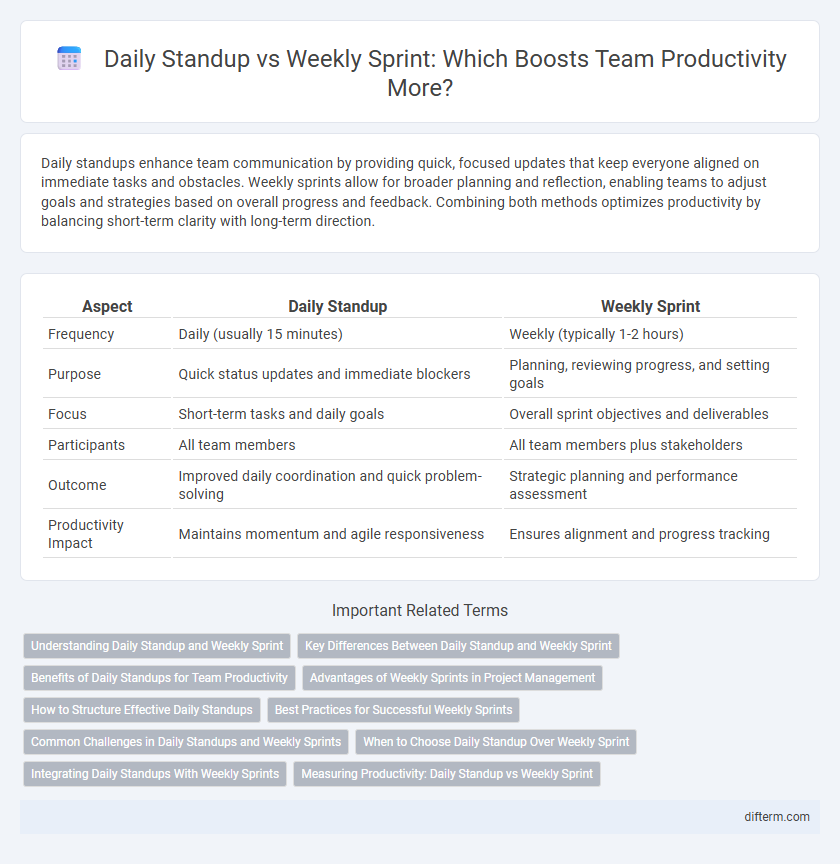Daily standups enhance team communication by providing quick, focused updates that keep everyone aligned on immediate tasks and obstacles. Weekly sprints allow for broader planning and reflection, enabling teams to adjust goals and strategies based on overall progress and feedback. Combining both methods optimizes productivity by balancing short-term clarity with long-term direction.
Table of Comparison
| Aspect | Daily Standup | Weekly Sprint |
|---|---|---|
| Frequency | Daily (usually 15 minutes) | Weekly (typically 1-2 hours) |
| Purpose | Quick status updates and immediate blockers | Planning, reviewing progress, and setting goals |
| Focus | Short-term tasks and daily goals | Overall sprint objectives and deliverables |
| Participants | All team members | All team members plus stakeholders |
| Outcome | Improved daily coordination and quick problem-solving | Strategic planning and performance assessment |
| Productivity Impact | Maintains momentum and agile responsiveness | Ensures alignment and progress tracking |
Understanding Daily Standup and Weekly Sprint
Daily standups foster continuous team alignment by facilitating quick updates on progress, impediments, and priorities, enhancing real-time collaboration and immediate problem-solving. Weekly sprints provide a structured framework for setting and reviewing short-term goals, enabling teams to plan, execute, and evaluate tasks within a defined cycle to boost productivity and delivery predictability. Understanding the balance between daily standup agility and weekly sprint planning is essential for optimizing workflow efficiency and maintaining consistent progress toward project objectives.
Key Differences Between Daily Standup and Weekly Sprint
Daily standups are brief, time-boxed meetings typically lasting 15 minutes, designed to synchronize team members by sharing progress, impediments, and immediate plans. Weekly sprints involve a longer planning and review cycle, where teams commit to and evaluate a set of tasks or user stories to achieve specific goals within the week. The key difference lies in the granularity and purpose: daily standups facilitate immediate coordination and quick issue resolution, while weekly sprints provide strategic alignment and comprehensive progress assessment.
Benefits of Daily Standups for Team Productivity
Daily standups enhance team productivity by fostering real-time communication, enabling quick identification and resolution of obstacles, and maintaining alignment on immediate tasks. These brief, focused meetings promote accountability and ensure continuous progress toward sprint goals, reducing delays and misunderstandings. Frequent interaction also boosts team morale and collaboration, leading to more efficient workflows compared to less frequent weekly sprints.
Advantages of Weekly Sprints in Project Management
Weekly sprints enhance project management by providing structured timeframes that improve focus and accountability within teams. This approach fosters continuous progress through iterative goal-setting, allowing for more comprehensive planning, problem-solving, and adaptability compared to daily standups. The extended duration of weekly sprints supports deeper task execution and reduces the overhead of constant meetings, driving higher productivity and clearer milestone tracking.
How to Structure Effective Daily Standups
Effective daily standups should be structured to last no longer than 15 minutes, focusing on three key questions: what was accomplished yesterday, what will be done today, and any blockers faced. Standups must encourage concise, focused updates that promote team alignment and quick issue resolution, avoiding detailed problem-solving. Maintaining a consistent time and virtual or physical location ensures punctuality and fosters accountability within agile teams.
Best Practices for Successful Weekly Sprints
Daily standups promote real-time communication and quick issue resolution, while weekly sprints provide a structured timeframe for goal achievement and in-depth progress evaluation. Best practices for successful weekly sprints include setting clear objectives, maintaining a prioritized backlog, and conducting thorough sprint reviews to ensure continuous improvement. Leveraging tools like Jira or Trello enhances transparency, accountability, and team alignment throughout the sprint cycle.
Common Challenges in Daily Standups and Weekly Sprints
Daily standups often face challenges such as time overruns, unclear agendas, and lack of participant engagement, which can reduce their effectiveness in maintaining team alignment. Weekly sprints may encounter difficulties like task prioritization issues, scope creep, and insufficient feedback loops, impacting overall productivity and sprint goal achievement. Addressing these common challenges requires clear communication protocols, structured meeting formats, and continuous process improvements to enhance team collaboration and delivery outcomes.
When to Choose Daily Standup Over Weekly Sprint
Daily standups are ideal for teams requiring immediate issue tracking and quick adjustments, fostering real-time collaboration and transparency. When project tasks are dynamic and rapidly evolving, daily check-ins help maintain alignment and prevent bottlenecks. Weekly sprints suit more stable workflows but lack the responsiveness needed for fast-paced environments that benefit from daily synchronization.
Integrating Daily Standups With Weekly Sprints
Integrating daily standups with weekly sprints enhances team productivity by maintaining continuous communication and immediate issue resolution while aligning progress with sprint goals. Daily standups provide real-time updates that keep team members accountable and enable quick adjustments, preventing sprint delays. Weekly sprints offer a structured timeframe for goal-setting and review, ensuring that daily efforts contribute directly to the overall sprint objectives and project milestones.
Measuring Productivity: Daily Standup vs Weekly Sprint
Measuring productivity through daily standups provides real-time insights into team progress, highlighting immediate blockers and enabling swift adjustments. Weekly sprints offer a broader performance overview, focusing on completed tasks and deliverables, which helps assess overall velocity and sprint goal achievement. Combining daily standups with weekly sprint reviews delivers a balanced approach, capturing both daily activity details and longer-term productivity trends.
Daily standup vs Weekly sprint Infographic

 difterm.com
difterm.com